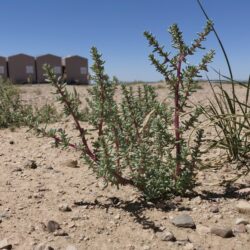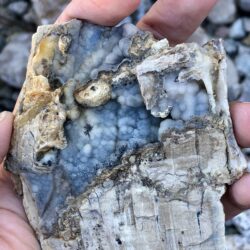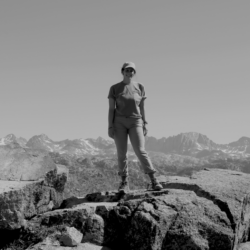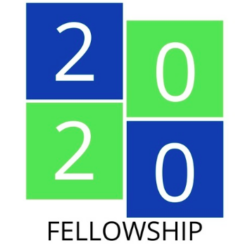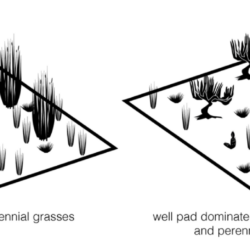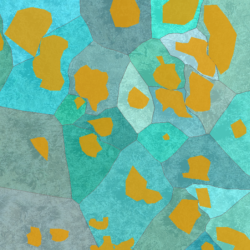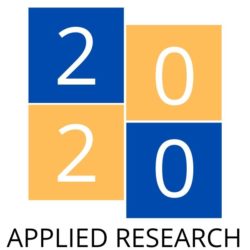Tag: Damaris Chenoweth
Exotic annual forbs present restoration challenges on natural gas well pads—Damaris Chenoweth
Restoration of natural gas well pads is plagued by invasion from annual forbs and grasses. Exotic annual forbs particularly are well suited to the sandy, salty, disturbed soils found on natural gas well pads in the Upper Green River Basin of southwestern Wyoming. While conducting research this summer on well pads in the Upper Green Read more about Exotic annual forbs present restoration challenges on natural gas well pads—Damaris Chenoweth[…]
Sampling soils in an ancient lake—Damaris Chenoweth
Some days our soil auger hits a layer of shale and instead of retrieving messy handfuls of sandy soil, we hear the dreaded grinding of steel on rock. We accept the disappointment of a missing data point because the alternative is to litter the ground with small holes to find a penetrable spot. Around 50 Read more about Sampling soils in an ancient lake—Damaris Chenoweth[…]
Assessing restoration outcomes on natural gas well pads in the Upper Green River Basin of Wyoming
The Jonah Field is a large natural gas field in southwestern Wyoming leased to energy operators by the U.S. Bureau of Land Management. The development of natural gas infrastructure is a large-scale disturbance on big sagebrush plant communities in this region. Reclamation is the mandated form of restoration meant to stabilize these disturbances after mineral Read more about Assessing restoration outcomes on natural gas well pads in the Upper Green River Basin of Wyoming[…]
Recording of Western Resources Fellow Presentations – Part 1
Hello everyone! Please click here to view the recording of presentations by 6 of our 2020 Western Resources Fellows. Each fellow presentation is about 10 minutes and below is the line-up: Abbey Warner Groundwater Conservation Easements in Southwest Colorado Margot Buckelew In-stream Flows in Colorado: Establishment and Opportunities Damaris Chenoweth Modeling Recovery of Big Sagebrush Read more about Recording of Western Resources Fellow Presentations – Part 1[…]
Understanding the Role of Perennial Grasses in Sagebrush Establishment — Damaris Chenoweth
I recently returned from Southwestern Wyoming where I collected data over five weeks. The undisturbed Wyoming big sagebrush of the Jonah Field is dotted by disturbed plant communities, in which perennial grasses often dominate during the early stages of plant community recovery after well pad establishment. When well pads are reclaimed—the practice of returning soil Read more about Understanding the Role of Perennial Grasses in Sagebrush Establishment — Damaris Chenoweth[…]
Mapping Resource “Neighborhoods” of Big Sagebrush — Damaris Chenoweth
Once covering nearly half of the American West, sagebrush ecosystems are now among the most threatened in North America. In the past century, climate change, human land use, shifting disturbance regimes, and the introduction of invasive plants have driven significant loss, fragmentation, and modification of sagebrush communities. As part of my research, I will characterize Read more about Mapping Resource “Neighborhoods” of Big Sagebrush — Damaris Chenoweth[…]
Simulating the Recovery of Big Sagebrush Communities from Disturbances Due to Oil and Gas Extraction
At well pads—areas developed for oil and gas drilling—both the vegetation and topsoil are completely removed. After drilling infrastructure is installed, these areas are reclaimed, meaning the topsoil is then replaced, and the areas are seeded with various mixes of species. Despite reclamation efforts, big sagebrush communities have an extremely hard time returning to a Read more about Simulating the Recovery of Big Sagebrush Communities from Disturbances Due to Oil and Gas Extraction[…]
Climate Vulnerability in the Crown of the Continent
UHPSI students collaborated with U.S. Fish and Wildlife Service to assist with a Landscape Conservation Design (LCD). The Crown Managers Partnership created this design to model spatially-explicit future conditions in the Crown of the Continent ecosystem, which encompasses parts of Montana, Alberta and British Columbia. As a preliminary step in LCD development, our student research Read more about Climate Vulnerability in the Crown of the Continent[…]

